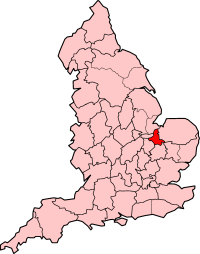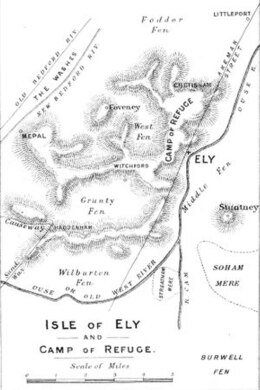Isle of Ely
| Isle of Ely | |
|---|---|
 | |
| Area | |
| • 1891 | 239,259 acres (968.2 km2) |
| • 1961 | 239,951 acres (971.0 km2) |
| • Coordinates | 52°24′N 0°15.5′E / 52.400°N 0.2583°E |
| Population | |
| • 1891 | 63,861 |
| • 1961 | 89,180 |
| History | |
| • Origin | Liberty of Ely |
| • Created | 1889 |
| • Abolished | 1965 |
| • Succeeded by | Cambridgeshire and Isle of Ely |
| Status | Administrative county (within Cambridgeshire) |
| Government | Isle of Ely County Council |
| • HQ | County Hall, March |
 | |
The Isle of Ely (/ˈiːli/) is a historic region around the city of Ely in Cambridgeshire, England. Between 1889 and 1965, it formed an administrative county.
Etymology
Its name has been said to mean "island of
History

Until the 17th century, the area was an island surrounded by a large area of fenland, a type of swamp. It was coveted as an area easy to defend, and was controlled in the very early medieval period by the Gyrwas, an Anglo-Saxon tribe. Upon their marriage in 652, Tondbert, a prince of the Gyrwas, presented Æthelthryth (who became St. Æthelthryth), the daughter of King Anna of the East Angles, with the Isle of Ely. She afterwards founded a monastery at Ely, which was destroyed by Viking raiders in 870, but was rebuilt and became a famous Abbey and Shrine.
The area's natural defences led to it playing a role in the military history of England. Following the
In 1216, during the
The Fens were drained beginning in 1626 using a network of canals designed by Dutch experts.[6] Many Fenlanders were opposed to the draining as it deprived some of them of their traditional livelihood. Acts of vandalism on dykes, ditches, and sluices were common, but the draining was complete by the end of the century.[7]
Administration

From 1109 until 1837, the Isle was under the jurisdiction of the
In July 1643 Oliver Cromwell was made governor of the isle.[9]
| Liberty of Ely Act 1837 | |
|---|---|
| Act of Parliament | |
 7 Will. 4 & 1 Vict. c. 53 | |
| Dates | |
| Royal assent | 15 July 1837 |
| Other legislation | |
| Repealed by | Statute Law Revision Act 1874 |
Status: Repealed | |
The Liberty of Ely Act 1837 (
Under the
Subdivisions
In 1894 the county was divided into county districts, with the rural districts being Ely Rural District, Thorney Rural District, Whittlesey Rural District, Wisbech Rural District, North Witchford Rural District, and the urban districts were Ely, March, Whittlesey and Wisbech (the only municipal borough). Whittlesey Rural district consisted of only one parish (Whittlesey Rural), which was added to Whittlesey urban district, in 1926.
The Isle of Ely parliamentary constituency was created as a two-member seat in the First and Second Protectorate Parliaments from 1654 to 1659. The constituency was re-created with a single seat in 1918. In the boundary changes of 1983 it was replaced by the new constituency of North East Cambridgeshire. Original historical documents relating to the Isle of Ely are held by Cambridgeshire Archives and Local Studies at the County Record Office in Ely.
Marquessate
The title Marquess of the Isle of Ely was created in the
References
- ^ Historia Ecclesiastica,IV:XIX
- ^ Hereward and the Isle of Ely, BBC History, accessed 6 January 2008
- ^ The taking of Ely, BBC History, accessed 6 January 2008
- ^ The Isle of Ely and Civil War: Trevor Bevis, Hereward of the Fens, (Cambridgeshire Genealogy), accessed 6 January 2008
- ^ "Wisbech and the civil war". Retrieved 12 January 2019.
- ^ "Cambridgeshire History & the Isle of Ely Timeline". Archived from the original on 17 June 2016. Retrieved 25 April 2013.
- ^ "The Draining of the Fens". Visit Ely. Archived from the original on 4 June 2016. Retrieved 10 March 2015.
- ^ Lewis, Samuel, Topographical Dictionary of England, Vol. II, London 1831
- ^ "Fenland riots". elystandard.co.uk. 7 December 2006. Archived from the original on 13 January 2019. Retrieved 12 January 2019.
- ^ "Town and county boundaries - First decisions of the Commission", The Times, 2 May 1947
- ^ a b "No. 6494". The London Gazette. 12 July 1726. p. 1.
- ^ "No. 6741". The London Gazette. 4 January 1728. p. 2.
- ^ "No. 9050". The London Gazette. 16 April 1751. p. 1.
Further reading
Fairweather, Janet (2005). "introduction". Liber Eliensis. Translated by Fairweather, Janet. Woodbridge, UK: Boydell Press. pp. Xiii–xliv.

